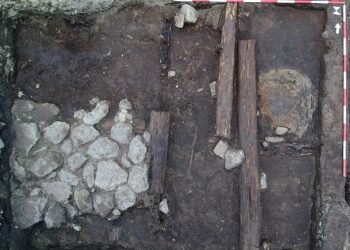Archaeologists from the universities of Cardiff and Reading have unearthed an extraordinary early medieval cemetery near Fonmon Castle in Wales. Dating back to the sixth and seventh centuries, the site contains around 80 bodies, offering a rare glimpse into the lives of individuals buried around 1,500 years ago.
The site has revealed around 80 bodies interred in graves that challenge conventional burial norms. Many skeletons lie flat on their backs, while others are carefully placed on their sides. Strikingly, a significant number of individuals, particularly women, are buried in a crouched position with their knees tucked against their chest—a unique feature not commonly found in other sites from this period.
Dr. Andy Seaman, a lecturer in early medieval archaeology at Cardiff University, said: “Sites of this date are extremely rare in Wales and often do not preserve bone and artifacts.” The meticulous excavation process has exposed burial rites that suggest a level of ceremony and differentiation among the individuals buried. All crouched burials are consistently oriented on their right-hand side, facing south, hinting at a coherent cultural or religious practice.

The researchers have uncovered more than just human remains, with fragments of glass from Bordeaux and pottery from North Africa providing insights into the privileged status of those buried at Fonmon Castle. Dr. Seaman remarked, “The presence of the important pottery and glass suggests activity of some status and significance.” This notion is further supported by the discovery of metalworking debris and a small bone peg, possibly used in games or as a musical instrument tuning peg.
Fonmon Castle, initially constructed around 1180 as a defensive keep, has become the focal point of this archaeological exploration. According to Daily Express, Nigel Ford, the current owner of Fonmon Castle, expressed his excitement, stating, “I am thrilled by this incredible discovery and find it fascinating. I can’t wait to find out more about the people who used to live at Fonmon and believe that we can learn valuable lessons from the past.”
Dr. Seaman emphasized that the site served purposes beyond burials, with evidence of ritual feasting inferred from fragments of rare imported glass drinking vessels and butchered animal bones. Geophysical surveys conducted in 2021 initially suggested an ancient farmstead, but detailed excavations revealed the hidden cemetery.
As the project unfolds, researchers aim to delve deeper into the lives of the ancient community. Jessica Morgan, a Cardiff University archaeology student involved in the excavation, expressed her enthusiasm, saying, “It’s brought me closer to my Welsh heritage. It is such an important and fascinating site.”
Summer Courts, an osteoarchaeologist involved in the excavation from the University of Reading, told MailOnline that the skeletal remains are in excellent condition. She highlighted the potential for learning about the inhabitants’ biological profiles, health, and even their physical activities. With the bones in excellent condition, stable isotope analysis and, potentially, ancient DNA analysis could provide additional information about migration patterns, family structures, and relationships within this ancient Welsh community.
Dr. Seaman remains optimistic about the ongoing excavation. He speculates, “The cemetery is enclosed by a series of ditches which might well suggest that there’s something more going on here.”






















Nunnery. Or is that too obvious?